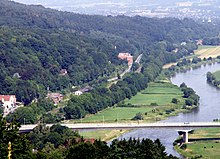Vlotho station
[7] The station is covered by Der Sechser (“the six”) fares of the Zweckverband Verkehrsverbund OWL (Ostwestfalen-Lippe transport association), which are valid as far as Rinteln, which is just into Lower Saxony.
In the upper area of the central section of the building, stucco decorations are centred on a round window.
Harmonious extensions to the original building were built in 1908/09 to a design of the architect Wilhelm Köster, who settled in Herford in 1892.
For centuries, the Vlotho port on the Weser was a trading centre for the Ravensberger Land and for the Principality of Lippe and for freight traffic to and from Bremen and Thuringia.
They feared economic disadvantages from its decline because of changes that had already occurred and the coming changes to the infrastructure (to roads and trails, as well as the increasing development of railways).
[10] This would lead to Vlotho continuing to be a major gateway to northern Lippe, which up to that time had been served by cart haulage.
During the construction of the Löhne–Hamelin line migrant workers from non-German speaking countries worked for the first time in the area; in Vlotho there were Poles.
[11] Construction work in Vlotho began in 1872 with the demolition of twelve houses in lower Langen Straße.
In the same year toilet facilities were installed in the building; these were made accessible from the station forecourt by an external staircase in 1968.
In the last days of the Second World War the railway bridge over the Weser river was attacked by Allied bombers, but it was not made impassable.
On 3 April 1945, when a panzer division was resisting advancing American troops in the area now called Exter, German pioneers attempted to impede the crossing of the Weser by blowing up the bridge.
During the postwar reconstruction, the rail link between the stations in Vlotho and Veltheim (Porta Westfalica) was reopened as a single track line in 1946.
The nearby Veltheim community power station, which was established in 1959, received a large proportion of its fuel by rail.




